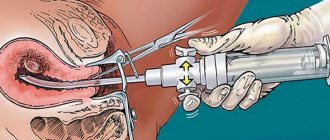Abortion
Termination of pregnancy is an operation performed in a medical institution, according to the testimony of a gynecologist, or the desire of a pregnant woman. There are 3 ways to carry out this procedure - surgically, medically, vacuum aspiration . In each case, their implementation involves interference with the functioning of internal organs, which may entail risks of complications. The doctor decides which one to use depending on the duration, contraindications for the patient’s health, and test results. Many women choose to have a vacuum abortion to reduce the risk of injury to the uterus.
Vacuum termination of pregnancy (mini-abortion).
The onset of pregnancy for a woman involves raising the question of her desire to have a child. Many pregnant women, taking into account life circumstances, decide to do vacuum cleaning . When registering a patient, a gynecologist assesses the state of reproductive health and sets a deadline. If she wishes to have a mini-abortion , the specialist determines whether this procedure can be carried out. If it is performed in a paid clinic, it is specified how much a mini-abortion , which is performed with a vacuum aspirator, costs.
Operating principle of vacuum abortion
Vacuum aspiration of the uterine cavity as a method of removing the fetus in a manner that is gentle on internal organs is practiced by gynecologists in the absence of contraindications for women’s health. The principle of operation is to clean the genitals and remove the fertilized egg using a pump. To do this, you do not need to use a Cusco speculum; it is enough to provide access to the vagina with a special catheter. Using the equipment, pressure is created, which promotes the separation of the fertilized egg from the walls of the uterus. For pain relief, the woman is offered anesthesia.
Vacuum flask
Work algorithm
This type of abortion can also be called vacuum aspiration. This name comes from two Latin words: breath and emptiness. Its meaning is as follows:
- The woman is exposed to local or general anesthesia.
- A catheter is inserted into the vagina (if this is the first pregnancy, then you must first expand it with a special device), due to which the uterine pressure becomes negative.
- The fertilized egg, which is still very poorly attached to the wall (it is important to know that abortion using the vacuum method is done only in the early stages), comes off.
- In the place where the fetus has become detached from the wall of the uterus, severe bleeding begins, which literally washes the child out of the vagina.
It's no secret that such a procedure is more gentle, softer than a regular abortion, in which the child is literally scraped off and torn off from the wall of the uterus. After this, the uterus becomes damaged.
Benefits of vacuum abortion
Compared to other types of abortion , performing a vacuum mini-abortion is safer for the patient. The benefits of this procedure include:
- the operation does not take much time;
- the genitals are less injured;
- painlessness - anesthesia is used;
- reduced risks of complications;
- rapid recovery of the body;
- possibility of carrying out in the early stages.
Taking into account the fact that the removal of the fertilized egg occurs using a pump, vacuum aspiration of the uterine cavity is carried out within 10 minutes. A mini-abortion does not require a woman to spend a long time in a health care facility; she can return home the same day, do her usual activities, and does not become incapacitated at work.
How long does a surgical abortion take?
Surgical abortion is considered the most traumatic method of removing the fertilized egg from the uterine cavity. However, this is the only abortion option that can be used up to 12 weeks. In addition, modern technologies make it possible to reduce the risk of complications to a minimum.
How long a surgical abortion takes depends, among other things, on the method of anesthesia. This choice is made by the gynecologist after preliminary diagnosis. The procedure can be performed under general (intravenous) anesthesia or local anesthesia.
At the next stage, the gynecologist carefully expands the cervical canal to a diameter of 10-12 mm. A curette or vacuum tip is inserted into its cavity. Using these instruments, the fertilized egg is removed from the uterus. To reduce the intensity of bleeding after curettage, the woman is prescribed medications that cause uterine contractions.
The fetal removal procedure itself takes about 10 minutes. However, preparation, anesthesia and postoperative monitoring together last about 3-4 hours. After this, the woman leaves the clinic. The main advantage of the surgical technique is 100% efficiency, since the doctor controls the progress of the procedure at all stages.
A medically safe abortion is performed in a short time, which allows the woman to quickly recover and return to everyday life.
Share link:
Disadvantages of vacuum abortion
For those women who decide to undergo vacuum aspiration, you should also be aware of the disadvantages of the operation. These include:
- the risk of incomplete removal of the embryo from the uterus (after identifying this situation, additional surgical intervention will be required);
- the occurrence of complications in the event of a procedure during an ectopic pregnancy (can happen if the diagnosis by the gynecologist is insufficient);
- get pregnant after a vacuum abortion after 6 months, during which time the body goes through a recovery stage.
To terminate a pregnancy, the time period from the moment of conception until the appearance of signs of pregnancy is important Vacuum aspiration of the uterine cavity is performed taking this factor into account, but after a complete diagnosis by a doctor. Some patients believe that going to commercial clinics is not relevant for them, since the method of carrying out the procedure is the same, such a service can be provided for free in a public hospital, so the question of how much a vacuum abortion costs does not arise for them.
Until what time is a vacuum abortion performed?
Women, turning to a gynecologist, are interested in: how long does it take to perform a vacuum abortion , how much does a mini-abortion procedure cost, using a vacuum aspirator . Before aspiration, the doctor must determine the gestational age. The opportunity to perform a vacuum mini-abortion appears already on the second or third day after a missed period. How many weeks this procedure can be done is determined by a specialist, taking into account the woman’s health condition. It is expected to be carried out up to 12 weeks, but after 7 weeks it is recommended to use the surgical method in practice.
Contraindications to surgical abortion
Since the operation is quite traumatic and it will take quite a lot of time to fully restore the body, it has the following contraindications:
- exacerbation of chronic diseases;
- pregnancy period is more than 12 weeks (in some cases - more than 22 weeks);
- ectopic pregnancy;
- infectious diseases.
If any diseases are detected in a woman, they should first be treated, and after recovery, surgical intervention should be performed.
Consequences and complications after vacuum abortion
Vacuum aspiration of the uterine cavity , like other methods of abortion, is stressful for the body. After surgery, a woman may experience complications. Consequences of vacuum abortion:
- spasm of the uterine muscles, accompanied by acute pain;
- incomplete removal of the fetus, which causes intoxication;
- damage to the internal genital organs;
- menstruation disorders;
- hormonal problems;
- bleeding;
- the occurrence of pneumoembolism (blockage of blood vessels, occurs due to improper supply of pressure to the uterus during an abortion);
- development of infectious diseases, sepsis;
- infertility;
- psychological problems.
The occurrence of complications depends on many factors, such as the experience of the doctor, the correctness of the procedure, psychological instability, and the state of the woman’s reproductive health.
Indications for vacuum abortion
Before performing vacuum aspiration, the doctor, in conversation with the patient, obtains information about her life and social circumstances, identifies medical factors that indicate the need for surgery, taking into account early pregnancy .
Abortion during pregnancy can be done when there are medical and social indications. The first group includes:
- The patient’s diagnoses are HIV, open form of tuberculosis, rubella;
- frozen pregnancy;
- pathologies of fetal development;
- the presence of endocrine, somatic and mental diseases.
The second category includes:
- the birth of a child provokes a deterioration in the woman’s health, including disability;
- being in prison;
- age under 18 and after 45 years;
- conceiving a child after violent acts.
If these circumstances exist and there are no contraindications, manual vacuum aspiration during pregnancy up to 12 weeks.
Frozen pregnancy
A pregnancy that stops progressing well before 40 weeks can happen to a woman of any age or health condition. This is caused by poor ecology, genetic failures, developmental defects, drug use or poisoning of the body, infectious diseases, and injuries. It happens that the fetus stops developing, but the reason is not at all obvious and cannot be established.
But despite this difficult situation for many ladies, you should show psychological fortitude and undergo a full examination. As a result, remains of the fetal membranes of a deceased fetus in the uterine cavity may be detected. If you do not get rid of them in time, the biological material undergoes necrosis and begins to decompose. In this form, it becomes an excellent breeding ground for bacteria. A woman may develop an infection that can lead to paralysis, removal of the uterus and ovaries, or even death.
During a miscarriage, the dead embryo often comes out on its own, but sometimes if the woman is not feeling well, an ultrasound examination reveals a frozen embryo. When the period is less than 5 weeks, a frozen pregnancy is determined by the absence of dynamics in the hCG analysis. In this case, the doctor may not prescribe an operation, but recommend that the girl expel the no longer developing embryo with the help of medications.
If during the examination it turns out that there was actually no embryo, but a defective conception occurred, then they speak of a hydatidiform mole. This is a pathology in which tissue growing in the uterine cavity does not become a fetus, but degenerates into a tumor, which can then metastasize to organs. In this situation, cleaning the uterus is necessary and it is strictly necessary to do it urgently.
After the vacuum aspiration operation (no matter whether it was done in the case of a frozen pregnancy or a hydatidiform mole), doctors carefully monitor the patient for several days. Monitor the temperature, an increase in which may indicate inflammation as a result of insufficiently high-quality cleansing. Even in the case of a satisfactory condition, the woman is prescribed a control ultrasound examination to ensure complete removal of the dead embryo.
Contraindications
Vacuum during pregnancy as a method of removing an embryo from the uterus is not used in every situation. When a woman makes an appointment to find out how many weeks a vacuum abortion lasts, how the operation takes place, and whether it can be performed, the gynecologist conducts a full diagnosis of reproductive health. Based on the test results, the following contraindications are identified:
- the presence of inflammatory processes in the body;
- infectious diseases of the genital organs;
- pathological conditions dependent on blood clotting;
- disturbances in the functioning of the cardiovascular system;
- allergic reactions to medications used for pain relief;
- ectopic pregnancy;
- less than 6 months have passed since the previous abortion or childbirth.
In these cases, vacuum aspiration is prohibited, so the doctor suggests other ways to carry out this procedure.
Painless procedure
A natural question is also “does it hurt to have a mini-abortion”? Since the operation is most often performed under local, and in some cases under general anesthesia, the procedure itself will not cause pain .
There may be quite significant discomfort during the opening of the cervix, nothing more.
After the completion of the mini-abortion, nagging pain in the lower abdomen is possible, since one way or another, aspiration is a surgical intervention in the body. But no particularly pronounced pain is felt during the procedure.
Where can I get a vacuum abortion?
Termination of pregnancy in the early stages is carried out only in health care institutions licensed to conduct medical activities.
In every city there are gynecological departments that operate both free and paid. Each woman in her locality is assigned to a clinic at her place of actual residence. If pregnancy is detected and there is a desire to do vacuum aspiration, the patient has the right to contact a gynecologist in a free hospital. Specialists will provide her with assistance, answer questions about how long a pregnancy can be terminated , how the surgical intervention occurs, talk about preparation, complications and contraindications.
If a woman wants to go to a paid hospital, she has the right to choose a medical institution after studying reviews of other patients and comparing the cost of the procedure in different clinics. How much a vacuum abortion costs in commercial clinics can be found on the websites of these organizations, without necessarily visiting a gynecologist.
Vacuum mini abortion: advantages of the procedure, indications, contraindications
Vacuum mini abortion is a procedure for terminating pregnancy in the early stages, widely used due to its advantages. Unlike traditional surgical abortion (dilatation and curettage (curettage) or dilation (dilation of the cervix) and evacuation), a vacuum mini-abortion is performed according to a different scheme using pressure, which avoids mechanical damage to the tissues of the uterine cavity and cervix. The main advantages of the procedure include:
- The duration of a mini abortion (vacuum abortion) does not exceed 10 minutes. In rare cases, if complications arise during an abortion, the duration of the procedure may increase to 30 minutes. Complications of this kind include instability of the patient’s condition, sudden deterioration in condition, severe bleeding;
- Carrying out the procedure with ultrasound monitoring, which eliminates doctors’ mistakes and significantly increases efficiency;
- In the absence of contraindications, a vacuum mini-abortion can be performed under medically induced sleep (general anesthesia);
- If a woman has already given birth, then cervical dilatation is not required for the procedure. When performing a mini-abortion, a nulliparous woman may require dilatation, however, in this case, the cervix is not injured in the same way as occurs when the cervical canal is dilated during a traditional surgical abortion;
- Fast healing and recovery process;
- Minimal risks to women's health;
- Low likelihood of complications;
- High efficiency.
There are a number of medical indications for performing a vacuum mini abortion, which include:
- Frozen pregnancy, anembryony;
- Deviations in fetal development;
- Threat to mother's life;
- The presence of infectious and parasitic diseases that can negatively affect the development of the fetus (all forms of tuberculosis, hepatitis, syphilis, HIV, rubella and contact with infection in the first trimester of pregnancy);
- Malignant neoplasms (or existing in the past) of any location;
- Diseases of the endocrine system;
- Diseases of the blood, hematopoietic system;
- Mental disorders incompatible with normal human life;
- Diseases of the nervous system;
- Congenital malformations;
- Forced intake of embryo- and fetotoxic drugs.
It should be noted that in many cases the indications for abortion are negotiable. In a situation where pregnancy exposes a woman’s body and life to danger, it is always necessary to weigh the risks. Many diseases are indirect indications for abortion. However, it is worth remembering that many malformations caused by certain disorders in the mother’s body can appear in the fetus in the later stages of pregnancy, when termination is impossible.
Contraindications to performing a vacuum mini-abortion are:
- The presence of acute infections, which increases the risk of infection spreading to the genital tract and the development of complications after the procedure. If you contact a gynecologist in a timely manner for a mini-abortion (vacuum aspiration), the patient undergoes a course of treatment for an infectious disease before the procedure;
- Ectopic pregnancy - localization of the fertilized egg outside the uterine cavity, which will not allow the aspirator to reach the implantation site and perform abruption and suction of the fetus;
- Poor blood clotting;
- Labor during the last 6 months;
- Unconfirmed pregnancy (pregnancy determined by a home test);
- Duration of more than 6 weeks - WHO allows vacuum abortions for periods of up to 12 weeks with proper qualifications of doctors, however, after 6 weeks of gestation, a strong connection between the chorion and the walls of the uterus is formed, which complicates the process of detachment of the fertilized egg and its removal from the uterine cavity.
How much does vacuum abortion cost?
In public clinics, if pregnancy , abortion can be performed free of charge. To do this, it is enough to make an appointment with a gynecologist, undergo an examination, take tests, and get information about vacuum abortion.
In commercial clinics, the cost of providing medical services is set. Information on how much a vacuum abortion costs is contained in the price list. In Moscow and nearby cities, the price of surgery is higher than in other regions. The determination of prices depends on the economic level of the territory, the cost of medications and instruments for the operation.
Preparation for vacuum aspiration
Before performing a vacuum mini-abortion, a woman needs to prepare for the procedure. No activities are planned at home. In the clinic at the patient’s place of treatment, the doctor diagnoses the state of reproductive function and prescribes tests. Based on their results and the fact of the examination, the specialist will tell you whether vacuum aspiration can be done.
Taking tests
In addition to physiological readiness, the girl will need psychological support. It is necessary to accept and understand the situation with the risks of health complications.
Tests and examinations before mini-abortion
When a patient goes to the hospital with questions: how does vacuum aspiration of the uterine cavity work, is it painful to have an abortion, how long can the operation be performed, the doctor tells her about all the features of the procedure and prescribes tests. Several types of examinations are carried out:
- urine;
- blood;
- vaginal smear for flora;
- ultrasonography;
- taking blood from a vein to check for hepatitis, HIV;
- PCR – to detect infections;
- bacterial culture from the vagina.
If a woman is registered with other doctors and has health problems, she is referred for additional examination. This is necessary to understand how abortion will affect your overall health.
Preparation
During an interrupted pregnancy and during the postpartum period, the list of necessary tests will be different. But such surgical intervention has general preliminary diagnostic recommendations:
- Test for hemophilia and blood clotting rate.
- A vaginal sample taken using a glass tube filled with cotton wool. It is sent to a laboratory assistant to identify bacteria and determine their types and quantities.
- Blood for biochemistry and general analysis.
- Cardiogram
- A smear to determine the presence of tumors, testing for both types of hepatitis, human immunodeficiency virus, and also, if suspected or indicated, for syphilis and other infections.
Also, before the operation, the gynecologist examines all chronic diseases that the woman has in her medical history and analyzes all the medications she takes. The doctor gives recommendations and prohibitions on taking certain medications a few days before the planned surgery.
To prepare for surgery, a girl should avoid contact of her genitals with cosmetic products; it is better to take a shower and wash herself with regular baby soap with a neutral pH. Sexual intercourse is prohibited 3-4 days before the procedure. You need to give up douching and suppositories.
The doctor may recommend not eating anything 8 hours before surgery and not drinking water 60-90 minutes before surgery. This way, anesthesia will be safer, and both the anesthesia and the operation itself will be easier to tolerate.
Stages of the operation
When a woman has received information from a gynecologist about whether it is painful to have an abortion, how long it can take to terminate a pregnancy, how much a vacuum abortion costs, she has undergone tests and, based on the results obtained, the doctor has given an opinion on the possibility of performing the operation, the specialist begins to perform aspiration.
Mechanism of the operation
How to do an abortion:
- the woman sits on the gynecological chair. The doctor applies anesthesia and treats the genitals with an antiseptic.
- If the girl has not yet given birth, a special dilator must be inserted into the cervical canal. If there has been a history of labor, the dilator is not used.
- After the anesthesia has taken effect, a vacuum aspirator is inserted into the uterus and the equipment is turned on, creating negative pressure inside. The surgeon passes the tip of the pump along the mucous membranes so that the amniotic egg detaches from the walls and comes out through a special tube into the vessel.
- After removing the instruments from the genitals, the woman is asked to stay in a medical facility for several hours to monitor her condition.
- If during this time she did not feel painful sensations that are not typical for the post-abortion period, and negative consequences did not appear, the girl can return to her normal life.
Answering the question: how to perform a vacuum mini-abortion, experts explain to the patient the mechanism of this procedure, warn about possible complications, and talk about caring for the genitals after a vacuum abortion .
After childbirth
During the postpartum period, the woman is observed by a gynecologist at the maternity hospital. The doctor assesses the patient’s body temperature, looks at the color and consistency of her discharge, whether the stitches are coming apart, how the mother is feeling and her general condition. It is extremely important to check whether there are any remaining particles of placenta or blood clots in the uterus. If there has been a rupture of the placenta, then the woman must be sent for a control ultrasound scan. This happens during a caesarean section. And also in the case when the fetal sac grows to the wall and has to be removed manually, helping the natural process.
If tissue remains are detected in the uterus, the doctor may first prescribe the woman to take a drug that will provoke contractions and push out pieces of the placenta along with the discharge. If this method turns out to be ineffective, the woman in labor may be prescribed vacuum cleaning.
If this is neglected, there is a risk of occurrence of foci of inflammation or a purulent process. In parallel, the patient is prescribed antibacterial therapy, and the genitals are regularly treated with an antiseptic.
Breastfeeding is discontinued during this period so that the child’s organs do not suffer from anti-infective drugs. To preserve lactation, milk is expressed and poured out.
Postoperative period
After a vacuum abortion, the body requires recovery within 6 months. During this time, there is a risk of complications, so the patient is recommended to be under the supervision of a gynecologist.
After an abortion is performed , the uterus actively contracts for several days to clear the cavity of remaining secretions through the cervix. The mucous membrane on the walls is restored within one month.
At the next stages of rehabilitation, stabilization of hormonal levels and the menstrual cycle occurs. To successfully pass this period, a woman must adhere to the doctor’s recommendations.
After a vacuum abortion is performed , it is prohibited:
- use tampons;
- visit the swimming pool, baths, saunas;
- allow intense physical activity.
Doing vacuum aspiration when pregnancy is detected at a very early stage is traumatic for the body. After an abortion is performed, the patient needs to monitor the functioning of the genitourinary system, intestines, and genital hygiene. If necessary, the doctor will prescribe a course of medication.
Medical abortion
Termination of pregnancy by taking pills is permissible at 4-5 weeks of pregnancy, while the fertilized egg is still too small. How long does a pill abortion last? This procedure lasts about two days. It begins with a single dose of the drug, which is prescribed by a gynecologist. Within 48 hours, the fetus dies and is spontaneously rejected from the uterine cavity, which is accompanied by minor bleeding. All this time, the woman is under the supervision of doctors on an inpatient or outpatient basis. A few days later, an ultrasound is prescribed, which is necessary to make sure that the fertilized egg has left the uterine cavity.
Terminating a pregnancy by using a drug is considered the safest method, as it has minimal unpleasant consequences for the woman. In addition, from a psychological point of view, it is much easier to tolerate than abortion using surgical instruments.
Pregnancy after abortion
Making a vacuum during pregnancy according to doctors’ indications and if the girl’s reproductive health is intact does not pose any danger and does not imply the development of infertility. How quickly the body recovers depends on how long the operation is performed, the experience of the surgeon, the quality of the procedure performed, and compliance with the gynecologist’s recommendations in the postoperative period.
Sex after vacuum interruption is possible after 3-4 weeks; until this time, sexual rest is necessary to restore the mucous membrane on the walls of the uterus. Partners should think about contraception; the most reliable method is taking medications that block conception. Complete rehabilitation occurs after 6 months from the date of surgery; during this time you should be observed by a doctor.
If a woman decides to do a vacuum during pregnancy, she must understand that the next full-fledged conception of a child occurs only when the mucous membrane of the uterine walls is completely restored. The fertilized egg will not be able to attach and a miscarriage will occur.
Sex after a mini-abortion
After vacuum aspiration, the patient cannot have sex for at least 3-4 weeks, and after the period of sexual rest has expired, it is necessary to use barrier contraception, which protects not only from conception, but also from various infections.
If, after interruption, the patient still feels signs of toxicosis such as nausea and gastronomic peculiarities, and testing shows two stripes, then this indicates the continuation of fetal development. In such a situation, you need to urgently go to the gynecologist.











